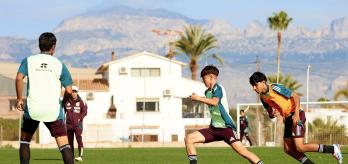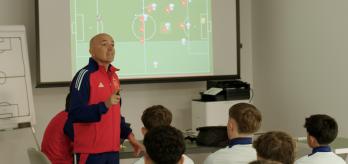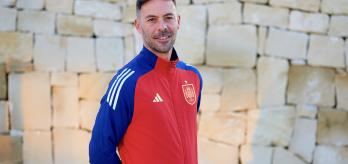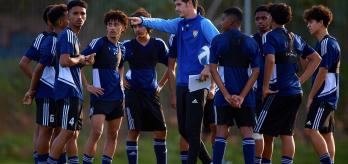The matchday-2 session focuses primarily on the defensive and offensive tactical roles and responsibilities. The team works on building play in a 4-3-3 system and prepares for Mexico’s 4-4-2 diamond pressing structure.
The session is led by the head coach of the UAE U15 boys’ team, Alberto “Beto” González, beginning with a joint mobility activation and passing circuit drill. The players then practise building play in a 4-3-3 system and pressing in a 4-4-2 formation in one half of the pitch. The third exercise is a 11v11 game that allows the players to fine-tune their build-up play and defensive strategy in game-like conditions. The session ends with defensive and offensive set piece preparation that focuses on attacking the front post.
Key coaching points
-
Passes should be precise, firm and accurate to ensure players are sharp for matchday. The players should play and press with intensity to maintain sharpness before matchday
-
Focus on typical movements in build-up play that work against a team using a diamond pressing system, such as congesting the central areas to give full-backs space and looking to create opportunities for overlaps.
-
Maintain intensity and use typical pressing actions so the team are prepared for the opposition’s defensive strategy and have a greater chance of progressing the ball.
-
Familiarise players with their defensive responsibilities when using mixed marking on set pieces. Players marking space should be ready to attack it and those using a player-oriented marking approach should get touch-tight and prevent the opponent from gaining momentum.
Part 1: Passing circuit & rondos
This initial activity consists of two separate activation exercises that focus on ball work and mobility. The first exercise is a mobility activation and passing combination activity and is followed by three rondos.
The first part is split into two exercises and should be organised as follows:
Part A - Passing circuit
-
Mark out four cones in the shape of a cross, each 35m apart.
-
Facing each cone, place a mannequin in the centre, positioned approximately 10m apart.
-
Position a pole between each cone on all sides, 5m off the line between each cone (see image).
-
Assign a player on each mannequin, one player on each pole, and three players per cone in total.
-
One spare player can take up a position on a pole.
Part B - Rondos 4v2 plus 1
-
Mark out three 10m x 10m areas.
-
Position one player on each of the four sides of the area and one player inside the area.
-
Place two players inside the area.
Part A - Passing Circuit
-
Players must pass and move in a clockwise motion.
-
The player at the cone passes to the player at the mannequin.
-
The player at the mannequin must then pass to the player at the pole to the left of the cone that the ball came from.
-
The player receiving at the pole must pass the ball to the cone to the left.
-
All players must follow their passes and move to the station where they have passed to.
-
Players should focus on controlling the ball and passing.
-
Six balls should be in play, and the activity must repeat continuously.
-
Switch direction and play in an anticlockwise motion.
-
Perform a series of stretches and mobility exercises before, during the switch, and at the end of the passing drill.
Part B - Rondos 4v2 plus 1
-
The four players positioned on the sides of the area and the player inside must work together to keep the ball between them.
-
They must aim to play through the player in the centre of the area.
-
The two defenders attempt to win the ball.
-
The player who loses the ball must switch with the defender who wins it.
-
Limit the players to two touches only.
Part A - Passing Circuit
-
In Part A, the receiving players must use the pole or mannequin as an opponent by positioning themselves directly behind it, then pulling away to gain a few metres and receive in space.
-
The player’s first touch must be out of their feet and into the direction they intend to play.
Part B - Rondos 4v2 plus 1
-
The players should play and press with intensity to maintain sharpness before matchday.
-
Focus on firm and precise passes to keep both drills running efficiently.
Part 2: Attacking and defending scenarios
This exercise focuses on UAE U15 boys’ preparation to build up and press against Mexico’s 4-4-2 diamond formation. In attack, the UAE will set up with a 4-3-3 system and press in a 4-4-2 system.
-
Begin by using one half of a full-size pitch.
-
Use a full-size goal and goalkeeper at one end of the pitch.
-
Position a mini-goal on either flank along the halfway line.
-
Mark out a halfway line inside the playing area.
-
Create a narrow zone through the playing area, starting from the lines of the six-yard box.
-
Set each team up with the respective 4-3-3 and 4-4-2 formations, but the attacking team does not use the three attackers, and the defending team does not use a back four.
This exercise is separated into two phases: attacking and defending.
Attacking phase – Build-up
-
The ball begins with the goalkeeper.
-
The team in possession must build an attack in a 4-3 formation.
-
Full-backs should be positioned high and wide. Midfielders must congest the central areas.
-
They must attempt to beat the press and score in one of the two mini-goals.
-
The defending team must press and try to win the ball.
Defensive phase – The press
-
The ball starts with the goalkeeper.
-
The defending team should be set up high in a 4-2 formation.
-
The defending team must press with two attackers.
-
The midfield should be positioned in a diamond shape.
-
The opposition’s number 6 should be marked in a player-oriented manner.
-
In the build-up, the midfielders must aim to disrupt Mexico’s pressing actions by condensing the middle and creating space for their own full-backs to receive.
-
Once the ball is played to either full-back, the midfielders must look for ways to receive, draw in the opposition, and switch play.
-
If the opposition midfielder over-anticipates the pass into the full-back, opening space inside, the centre-backs can look to progress through the centre.
-
The press must be done intensely to replicate game-like conditions.
-
When pressing, the number 8 and number 10 must focus on protecting central areas and decide whether to shut off central lanes or jump out to press the full-backs.
Part 3: 11v11 game
This practice is designed to help the coach refine the defensive and offensive aspects of the game plan in preparation for the match. The coach emphasizes the following aspects of the game: Goal kicks, build-up, open play, high pressing, and low blocks.
-
Use a full-size pitch.
-
Use a full-size goal and goalkeeper at each end of the pitch.
-
Play a 11v11 game. Both team attack in a 4-3-3 and defend in a 4-2-3-1.
-
Start with the goalkeeper of the blue team having possession of the ball.
-
The blue team must build in a 4-2-3-1 formation and try to score in the opposite goal.
-
Out of possession, the orange team defends in a 4-3-3 high-press formation.
-
The orange team must try to win the ball high up the pitch and score.
-
Game scenario - Prepare to defend a lead and conserve energy by switching to a compact medium block.
-
Encourage the winger to drift inside, creating space for the full-back to exploit high and wide.
-
Attackers and midfielders must provide passing options by dropping to receive, while also helping to draw out defenders.
-
Pressing aggressively in a pair to quickly shut off passing options from the goalkeeper to the centre-backs.
-
When pressing high, the defenders must be prepared for the opposition’s long balls by positioning themselves with a side-on body posture, allowing them to turn and sprint back while keeping their eyes on the ball and attacker.
Part 4: Offensive and defensive set pieces
This final section of the session prepares the players for their offensive and defensive responsibilities from set piece. The players also prepare for the opposition’s set-piece strategies.
This exercise is split into two separate drills: defensive and offensive.
-
Use one half of a full-size pitch.
-
Use 1 full-size goal and goalkeeper.
-
Set up ten defenders and seven attackers.
-
Position one defender at the front post, two defenders on the edge of the small area and two defenders on the edge of the area.
-
Position five attackers, from the penalty spot to the edge of the area, coming from the back.
-
Assign five defenders to mark the attackers in a player-oriented fashion.
-
Position one attacker outside the area and one attacker taking the corner.
-
The attackers must attack different points around the goal.
-
The defenders must defend the cross and prevent a goal.
-
Take two corners one each side.
-
Vary between inswinging and outswinging crosses.
-
Position the players in the same setup as the defensive set-piece organisation.
-
9 attacking players against 8 defending players.
-
Three attackers are positioned outside the area, prepared for second balls and transition moments.
-
When the corner comes in, four attackers should attack the front post.
-
The attacker closer to the front must peel off and make a run around the back.
-
Play until a goal is scored or the defending team makes a clearance.
-
Prepare for the possibility of a short corner. If the player outside the area goes short, the player on the front post and one of the players on the edge of the area must get out to prevent the cross.
-
Players marking space must anticipate the flight of the ball, the movement around them, and be ready to aggressively attack the ball.
-
Those who are player-to-player marking must make sure the attacker does not gain an advantage or space to attack by staying touch-tight and preventing movement.
-
When attacking a set piece, players can use feints and fake body movements to confuse the defender and create space to attack.
-
Communicate or signal the area each player will attack to ensure they do not make the same runs and block each other.
-
Having two or three players attack the front post can increase the likelihood of making contact with the ball.













